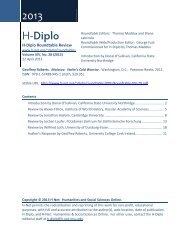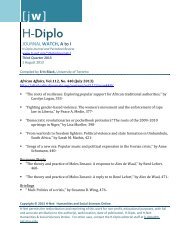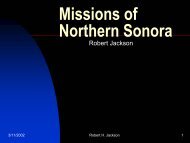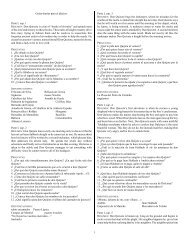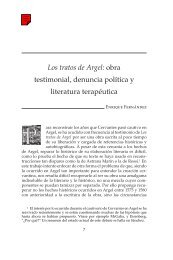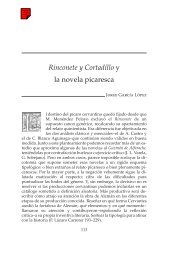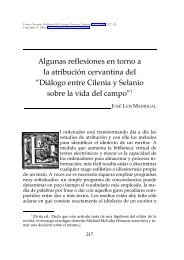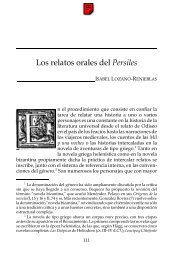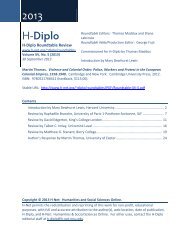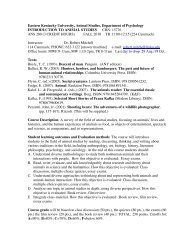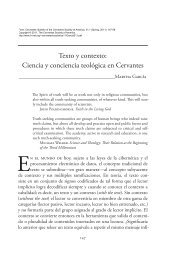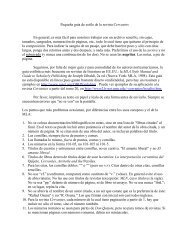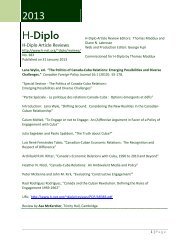El ingenioso hidalgo don Quijote de la Mancha, ed. Tom ... - H-Net
El ingenioso hidalgo don Quijote de la Mancha, ed. Tom ... - H-Net
El ingenioso hidalgo don Quijote de la Mancha, ed. Tom ... - H-Net
You also want an ePaper? Increase the reach of your titles
YUMPU automatically turns print PDFs into web optimized ePapers that Google loves.
Reviews<br />
Cervantes Saav<strong>ed</strong>ra, Miguel <strong>de</strong>. <strong>El</strong> <strong>ingenioso</strong> <strong>hidalgo</strong> <strong>don</strong> <strong>Quijote</strong> <strong>de</strong> <strong>la</strong><br />
<strong>Mancha</strong>. Ed. <strong>Tom</strong> Lathrop. Newark, De<strong>la</strong>ware: Juan <strong>de</strong> <strong>la</strong> Cuesta,<br />
1998. xxxii 871 pp. in two volumes. (Volume I, “revis<strong>ed</strong> and correct<strong>ed</strong><br />
<strong>ed</strong>ition.”) Lathrop, <strong>Tom</strong>. Don <strong>Quijote</strong> Dictionary. Newark,<br />
De<strong>la</strong>ware: Juan <strong>de</strong> <strong>la</strong> Cuesta, 1999. vi 150 pp.<br />
Cervantes’s contemporaries wait<strong>ed</strong> ten years for his second part of Don <strong>Quijote</strong>,<br />
but the wait is over for American un<strong>de</strong>rgraduates. Just two years after<br />
the appearance of <strong>Tom</strong> Lathrop’s <strong>El</strong> <strong>ingenioso</strong> <strong>hidalgo</strong> <strong>don</strong> <strong>Quijote</strong> <strong>de</strong> <strong>la</strong> <strong>Mancha</strong><br />
(Parte I), Juan <strong>de</strong> <strong>la</strong> Cuesta has publish<strong>ed</strong> Lathrop’s Part II and the Don <strong>Quijote</strong><br />
Dictionary as well as a revis<strong>ed</strong> and correct<strong>ed</strong> Part I. These volumes, an alternative<br />
to Spanish <strong>ed</strong>itions of Don <strong>Quijote</strong>, will enable English-speaking stu<strong>de</strong>nts to<br />
read and un<strong>de</strong>rstand Don <strong>Quijote</strong> more easily.<br />
Bas<strong>ed</strong> on the Schevill-Bonil<strong>la</strong> <strong>ed</strong>ition (1928–41), Lathrop’s Part I and Part II,<br />
with mo<strong>de</strong>rniz<strong>ed</strong> spelling except when pronunciation would be affect<strong>ed</strong>, have<br />
special features to make Don <strong>Quijote</strong> more accessible. In addition to frequent<br />
vocabu<strong>la</strong>ry glosses in English in the right margin of each page, Lathrop’s Don<br />
<strong>Quijote</strong> also has abundant lexical, grammatical, and cultural exp<strong>la</strong>nations in<br />
English in footnotes at the bottom of the page. In the windmill episo<strong>de</strong> in Chapter<br />
8 of Part I, for example, Lathrop’s 51 footnotes and approximately 130 vocabu<strong>la</strong>ry<br />
glosses outnumber John Jay Allen’s six notes, Martín <strong>de</strong> Riquer’s<br />
twenty, and Luis Andrés Murillo’s thirty-three. Lathrop’s entries are generally<br />
more appropriate for un<strong>de</strong>rgraduate rea<strong>de</strong>rs.<br />
Lathrop has also inclu<strong>de</strong>d headlines in English that summarize highlights of<br />
the text at the top of each page, a tool that stu<strong>de</strong>nts can use as a pre-reading summary,<br />
a comprehension check while reading, or a review soon after reading or<br />
right before an exam. Gustave Doré’s illustrations offer rea<strong>de</strong>rs visual support<br />
as they move through the story, and the line numbers in the left margin and section<br />
numbers at the top of left-hand pages are useful for finding references during<br />
c<strong>la</strong>ss discussion. Lathrop’s introduction clearly exp<strong>la</strong>ins these features.<br />
Although Lathrop’s <strong>ed</strong>ition <strong>la</strong>cks an extensive bibliography of critical works,<br />
which would appeal to graduate level rea<strong>de</strong>rs, this does not seem to be a serious<br />
omission, given the un<strong>de</strong>rgraduate target audience.<br />
The revis<strong>ed</strong> version of Part I is very simi<strong>la</strong>r to the first <strong>ed</strong>ition, which was<br />
publish<strong>ed</strong> in 1997, in content and format, although many of the typographical<br />
179
180 Reviews Cervantes<br />
errors have been correct<strong>ed</strong>. The introduction still inclu<strong>de</strong>s sections on Gol<strong>de</strong>n<br />
Age grammar, Cervantes’s life, the contradictions and suppos<strong>ed</strong> errors in Cervantes’s<br />
text and chapter titles, the characters Marce<strong>la</strong> and the fictional Cervantes,<br />
the clergy, and the <strong>ed</strong>itions of Don <strong>Quijote</strong> consult<strong>ed</strong>. One significant<br />
change is the improv<strong>ed</strong> wording in the footnotes. Instead of giving only one<br />
Spanish word to help rea<strong>de</strong>rs locate the p<strong>la</strong>ce in the text, the revis<strong>ed</strong> entries usually<br />
begin with several words or a phrase.<br />
Part II, which begins with page 425, where Part I en<strong>de</strong>d, follows the format<br />
of Part I. The second volume inclu<strong>de</strong>s an introduction in which Lathrop<br />
discusses Cervantes’s reaction to Avel<strong>la</strong>n<strong>ed</strong>a’s continuation of Don <strong>Quijote</strong>.<br />
After mentioning the tradition of sequels publish<strong>ed</strong> by authors who had<br />
not written the original texts, Lathrop suggests several reasons why Avel<strong>la</strong>n<strong>ed</strong>a<br />
would not have felt it improper to continue Cervantes’s work. Then<br />
Lathrop offers examples of some ways in which Cervantes’s Part II responds to<br />
the spurious sequel. The introduction ends with the note that Life magazine<br />
list<strong>ed</strong> Don <strong>Quijote</strong> as ninety-seventh of the one hundr<strong>ed</strong> greatest events of the<br />
millennium.<br />
Since many stu<strong>de</strong>nts do not have dictionaries with Gol<strong>de</strong>n Age words and<br />
<strong>de</strong>finitions, and even <strong>la</strong>rge dictionaries sometimes require supplements, the<br />
third volume of this set is especially useful. Lathrop prepar<strong>ed</strong> the Don <strong>Quijote</strong><br />
Dictionary to help un<strong>de</strong>rgraduates easily find the right nuances of words. According<br />
to the introduction, the 7,800 entries inclu<strong>de</strong> 12,000 <strong>de</strong>finitions. Since<br />
each meaning of a word is only gloss<strong>ed</strong> once in the margins of the text, the dictionary<br />
allows stu<strong>de</strong>nts to verify meanings that they have forgotten. Uncommon<br />
and quite common words and meanings appear in the dictionary, and the<br />
entries list the part and chapter numbers of where each <strong>de</strong>finition is first us<strong>ed</strong>.<br />
Lathrop aim<strong>ed</strong> to enable stu<strong>de</strong>nts to read Don <strong>Quijote</strong> without referring to a<br />
trans<strong>la</strong>tion, and a close consi<strong>de</strong>ration of the windmill adventure in the first section<br />
of Part I, Chapter 8, shows that stu<strong>de</strong>nts will ne<strong>ed</strong> to look up few, if any,<br />
words in another dictionary because so much of the vocabu<strong>la</strong>ry is exp<strong>la</strong>in<strong>ed</strong> in<br />
the margin, notes, and Don <strong>Quijote</strong> Dictionary. In many lines, several words or<br />
phrases are <strong>de</strong>fin<strong>ed</strong>. Although stu<strong>de</strong>nts will still have to read carefully in or<strong>de</strong>r<br />
to un<strong>de</strong>rstand the text while consulting Lathrop’s dictionary and notes, the <strong>de</strong>finitions<br />
in these volumes will spe<strong>ed</strong> up the reading process. Lathrop’s soft-cover<br />
dictionary is also more portable than a <strong>la</strong>rge one for stu<strong>de</strong>nts who study at different<br />
p<strong>la</strong>ces on campus between c<strong>la</strong>sses and at home.<br />
Lathrop’s Don <strong>Quijote</strong> offers an alternative to Spanish <strong>ed</strong>itions for instructors<br />
who do not mind having extensive notes and glosses in English. In addition to<br />
the comparative ease of reading Don <strong>Quijote</strong> in this format, the attractive covers<br />
and illustrations and compact size should make Lathrop’s Don <strong>Quijote</strong> popu<strong>la</strong>r<br />
with stu<strong>de</strong>nts, although most of them will not have struggl<strong>ed</strong> through a Spanish<br />
<strong>ed</strong>ition previously. At $20 for Part I, Part II, and the dictionary, this set will<br />
save stu<strong>de</strong>nts time, energy, and money. In his introduction to Part II, Lathrop<br />
mentions that Juan <strong>de</strong> <strong>la</strong> Cuesta is consi<strong>de</strong>ring publishing other works with a<br />
simi<strong>la</strong>r format, and judging from this careful stu<strong>de</strong>nt-orient<strong>ed</strong> <strong>ed</strong>ition of Don
20.1 (2000) Reviews 181<br />
<strong>Quijote</strong>,these books would be welcome options among Spanish <strong>ed</strong>itions of long<br />
or difficult texts.<br />
Gwen Stickney<br />
Indiana University



